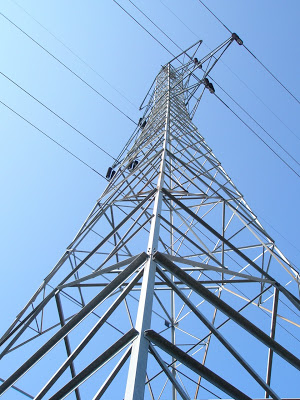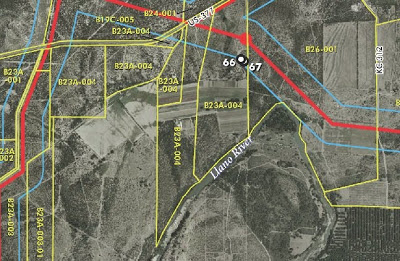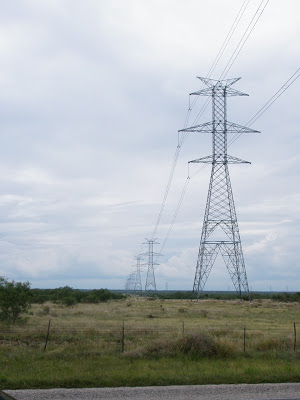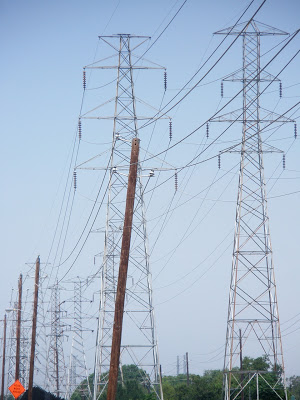Proposed high-voltage power lines
Endanger unique Hill Country habitat
By Sarito Carol Neiman / The Rag Blog / July 31, 2010
When I came back to New York City a couple of years ago after a year’s “sabbatical” in my native Texas, I signed up for wind as the source of my electricity to be delivered by ConEd.
Being a “green” kind of person, I felt somewhat virtuous about this, despite the patent ridiculousness of the very idea that my personal kilowatts would now magically come from a windmill somewhere upstate, while those of my heedless neighbor in the next apartment would still be generated by planet-heating coal.
Then the news came from the folks back home, and the bigger picture was suddenly thrust before my city-dwelling, can’t-see-past-the-next-corner eyes.
On July 29th, the Lower Colorado River Authority (LCRA) submitted its revised “Certificate of Convenience and Necessity” (CCN) to the Texas Public Utilities Commission (PUC) for the construction of high-voltage electric transmission infrastructure across the Texas Hill Country.
After months of hearing from the public about the potential irreversible damage to the environment, the economy, and the livelihoods of those affected by the proposed lines, the revisions looked very much like the original proposals, only just more complicated and with a clearer effort to do a better PR job than the first time around.
Here’s what I posted to my Facebook page as soon as I got the latest, updated aerial photo of the patch of ground in that affected region closest to my heart.
See the three yellow boxes just above and to the left of the words “Llano River.” That’s the family farm. See the white dots… numbered 66 & 67. Those are where I have enjoyed some of the best meals and most loving gatherings I’ve ever experienced in my life, with family and friends. See the big red lines. That’s where the “preferred route” is located for sending West Texas wind energy to the I-35 corridor to light up and air condition urban landscapes where you can’t see the stars or smell the breeze blowing out of the hills. See the big red spot. That’s where one of those big, 14-story made-in-Mexico steel lattice towers will be planted to hold up the lines (those lines where you can stand underneath and hold a fluorescent bulb in your hand and it will light up on its own).
Meantime the bro’ in his Kerrville TV station interview the other day took the lady’s question about his personal property situation and turned it round immediately to the question even closer to his heart, which is about preserving one of the most amazingly ecologically diverse open spaces left in the state of Texas, and among the top 20 in the world. I am not so generous as he is. I am really, really pissed. Because my brother and his family — my family — are the connection of this old city-dweller and rootless vagabond to my roots, and to the land.
Run, Spot, run. Or else I am coming after your head on a platter.
If, like me, you’re a city dweller who wants to support green energy, here are some links to the bigger picture. Between now and the end of August there is an opportunity for more public input — and I’m sure those who live in the Hill Country and will be directly impacted by this very un-green infrastructure would appreciate support from some of the intended consumers living at the end of the line along the I-35 corridor.
[Carol Neiman, a founding editor of the original Rag in Austin, coauthored A Disrupted History: The New Left and the New Capitalism, and has written or edited a number of other books. She lives in New York City but wishes she were back on a front porch in Texas, drinking a margarita.]
- Watch the Clear View Alliance informational videos and send a message (provided on the website) to the Public Utilities Commission affirming your support for “green” power transmission infrastructure as well as green energy.
- Find out other ways you can lend your support to Hill Country landowners and environmentalists.
- Also see “Blowing Through Texas: Renewable Energy Ploy Brings an Ill Wind” by Sarito Carol Neiman / The Rag Blog / June 18,2009






















Wind power is potentially a good (or, at least, better) thing.
But it ain’t just what you do, it’s the way that you do it. So far, it seems like the decision-making process here has been democratically inept and much too influenced by special interests. Giving the issue a higher public profile will hopefully generate sufficient political pressure to make the process more open and, assuming that more benign alternatives are available, less deleterious in its implementation.
Progressives wage war against the oil biz, the new-cue-ler biz, and the coal biz. You organize and rally to get the attention of policy makers and legislators for your agenda of green energy.
So what do you do when you succeed at getting capitalism to incorportate environmentalism? Why of course you whine. Those solar and wind farms are built far away from urban centers. And now you
I'm not an engineer, but maybe this would be a place for that old chimera, hydrogen. Use the electricity to make hydrogen out there at the wind farms; put it into seriously secure tank cars; train it to the cities; and generate the electricity there.
There'll be some loss in electricity transmission, just as there'd be some loss in hydrogen production. I don't
TomD, I don't know enough really to comment on your question, but I do feel that the really "smart" solution for the grid of the future is to shift to generating power closer to the source, by whatever means make the most sense given the location and its resources. As long as we are hooked on centralized power production and long-distance distribution of same, our imaginations are
I meant to generate power closer to where it's needed, of course. Not closer to the source of where it's generated. (Long day). City level, small town level, neighborhood, household. Surely we're smart enough to figure out how to do that? And we can use the existing grid as a back-up till we get it figured out, instead of adding more monster towers to a system that doesn't work
. . . Furthur support for TomD’s suggestion can be gleaned from past NM wind-farm developer, and author/politician Harry Braun’s websites http://PhoenixProjectFoundation.US and https://P3amendments.US/Amendments.html … pictured on the long-scroll first site are underground pipelines for communications, energy, and fuel in liquified hydrogen.
. . . At those cold temperatures, power transmission does not suffer resistance-loss and heat generation, and the pipes can also be used to transport the fuel itself, which is demonstrably safer than oil. Hydrogen can be produced by running the cheap wind power through water, splitting it into its elements. Besides compression as a gas, hydrogen can be chilled to liquid form, and travel through insulated pipes underground below landscapes where their visibility is undesirable.
. . . Yes, expensive to build … but then free payback in decades of efficient service without visual or environmental pollution (hydrogen rises away if burned, and combines with oxygen to produce clean water).
Hello Carol,
Nice article. Since you are talking about high voltage, have you heard anything from your old pal Lightning Rod lately? If not, here I am.
http://www.thepoetseye.wordpress.com
gimmie a shout
Lrod